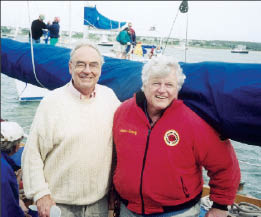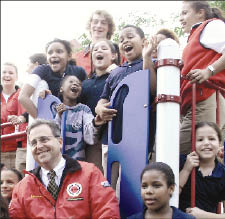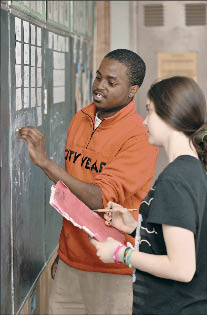 |
|
The Red Jacket: Former Sen. Harris Wofford with Sen. Ted Kennedy, who often donned his City Year jacket for sailing. Photo: City Year |
A lingering memory: Ted Kennedy, his wife Vicki and their two dogs returning from a day of sailing, the senator’s rosy cheeks nearly as bright as his red jacket, which bears the logo of City Year.
Then another: A bevy of those red jackets flood the area around Boston’s Our Lady of Perpetual Help church on the gray August day that Kennedy is buried. The young people who wear them direct traffic, hold umbrellas, help those who walk with difficulty, park cars – anything to assist at the senator’s funeral.
Reporters note during their broadcasts that the youths are from Boston City Year, a national service group and a favorite of Kennedy, who long had championed its cause and that of national service – to the point that the Serve America Act that Congress passed this year bore his name.
It was an unusually somber event for the youths of City Year. Usually, they can be found cheerfully greeting thousands of American children every day at schools across the country, checking on youngsters who don’t show up for classes, encouraging play during recess and conversation during lunch, and helping students with their homework in the afternoon.
Over the past two decades, Boston-based City Year and its progeny in 18 other U.S. cities have come to be considered the elite AmeriCorps program. Not just for their recognizable uniforms (outerwear and boots by Timberland, pants and shirts from Aramark) or the tools they carry (cell phones and BlackBerries by T-Mobile) or the diversity of their ranks (each team balanced by ethnicity, racial background, regional origin and sexual orientation), but also for how the organization has leveraged donations from major corporations into partnerships that have resulted in greater public service from the donors themselves.
In many ways, City Year was the first service organization to embrace fully the American business model – including management studies, strategic planning and techniques for expanding – leavened with heady devotion and service.
And along the way, it became the 800-pound gorilla of the American service movement, the program that others privately wish they could emulate, while also dreading that it could move into their towns and drown them in its wake.
“City Year sucks all of the oxygen out of a room,” the head of one national service nonprofit says, complaining about the group’s drain on scarce local funding sources and its penchant for garnering headlines.
The beginning
 |
|
On the playground: City Year CEO Michael Brown, front left, with youth mentored by the group. Photo: Andy Dean |
Alan Khazei (rhymes with “easy”), now a candidate for Kennedy’s Senate seat, and his Harvard roommate, Michael Brown, founded City Year largely on a notion of service – some might say good intentions without a lot of focus. Both are law school graduates, hardly trained in youth development or education.
But they worked intensely. They arranged congressional internships for themselves, sparked a congressional hearing on service, and when the national service bill they were championing (and which they hoped might provide funding for their planned project) failed to go anywhere, they started City Year in 1988 anyway, with money donated by the Bank of Boston (now Bank of America).
The primary attention then was on the development of a greater spirit of service in City Year corps members themselves, one that would last a lifetime. The first class was a mix of high school dropouts, college dropouts and some college graduates. They did a wide variety of projects: reclaiming public spaces such as gardens and playgrounds, community organizing leading to community clean-up projects, and short stints of tutoring.
(Khazei left City Year two years ago to head Be the Change and ServiceNation, and to lead the coalition that promoted passage of the Serve America Act. Brown, now the CEO, said Khazei’s run for Senate (in which Khazei repeatedly trumpets his City Year triumphs) has had no effect on City Year and that City Year has no role in Khazei’s campaign.)
Brown says the approach was pretty scattershot. “City Year wanted to say yes to a lot of community organizations who wanted teams” and to demonstrate the idea of national service, he said.
 |
|
Tutoring is a major part of City Year’s Whole School, Whole Child program. Photo: David Debalko |
A 2007 evaluation of City Year’s impact on corps members’ civic engagement showed that a slightly higher percentage voted in the 2004 presidential election than a control group who had not been in City Year (89 percent to 87 percent); that substantially more voted in local elections (59 percent to 40 percent); and that two years after their City Year stints, 70 percent of former corps members were volunteering, compared with 57 in the control group.
More focus on youth
About 10 years ago, City Year began to focus on serving youth almost exclusively. “Over time, we realized the work of our corps – 17- to 24-year-olds – could have a particular impact by working with children,” said Brown.
That belief led to the creation six years ago of City Year’s Whole School, Whole Child program. It included what Stephanie Wu, senior vice president of program, evaluation and service, described as “education thought leaders” helping to assess what City Year corps members did best in contributing to schools and to determine the best practices for expanding the corps’ role.
On the one hand, the program concentrates on helping individuals through mentoring and after-school activities, specifically in math and science. Corps members, who are with the children from the time they arrive at school until they leave in the late afternoon, have different relationships with the students than the children have with their teachers, and corps members often see behaviors that give clues to why the youths are struggling in school. The City Year teams work with the teachers in planning special attention for those children.
At the same time, corps members target a school’s atmosphere and culture, striving to engender the idea that school is a place for learning, not strife. In addition to greeting students heartily every morning and staying with them through recess and lunch, corps members plan whole-school activities that foster more interaction among all the students and create a sense of teamwork and reliance on others.
City Year’s former vice president for research, Andrew Munoz-Schneider (now vice president of the Academy for Educational Development, headquartered in Washington, D.C., and co-director of its Center for Youth Development and Policy Research), said the Whole School, Whole Child program was tested for three years in selected schools, while educational researchers worked to refine the plan. Over the past three years, it has expanded to almost all schools in all City Year locations.
Local school officials choose the schools for participation, and they are usually those with some of the most serious problems – as Munoz described them, “the six toughest schools in Philadelphia.”
“They have no fear of going anywhere, anytime,” Munoz said of City Year teams.
But while students and principals have reported marked improvements in attendance, behavior and academic work in children that City Year members have mentored, there are no definitive evaluations. Formal evaluations are under way in Miami, Philadelphia and Chicago.
In school and on track
Today, City Year is zeroing in on the dropout problem. It is working off research by Johns Hopkins University professor Robert Balfanz and others that found that about 2,000 of the nation’s 11,000 high schools are responsible for about half the nation’s dropouts. (Robert Balfanz is the brother of Jim Balfanz, City Year’s chief operating officer.)
Brown is succinct when asked why the shift to educational service: “It’s where we can have the greatest impact.”
Jim Balfanz said that honing in on the schools with the greatest dropout problems may mean moving out of some City Year schools, but it does not require a major relocation of programs. Most of the participating cities have some of the schools with the nation’s worst dropout rates. Milwaukee, slated to become the 20th location, is rated fourth on the dropout list. Of the top 10 cities with the worst dropout problem, City Year is already serving five, he said.
“We don’t have to move base to have a major impact; we are at the epicenter of the problem in urban areas,” Balfanz said.
City Year’s new goal is to scale up to running teams in half the schools with the worst dropout rates in its location cities. They will work with youth in the feeder elementary and middle schools to make certain that by the time those youths are in the 10th grade, they are “in school and on track.”
Tenth grade is a crucial one for dropping out, Balfanz said; if students can make it through that year, they are likely to graduate.
Because other research has identified dropout predictive markers that show up as early as the sixth grade – poor attendance, mild misbehavior and poor course performance in English and math – those are the areas corps members will address, much as they do already in Whole School, Whole Child.
Scaling up
This school year, City Year has about 1,500 corps members. To reach its goal of saturating 50 percent of the worst dropout producers in their service cities will take about 5,000 corps members a year, Balfanz estimates. For example, in Boston, where the corps is now 144 strong, it would take 350 corps members to reach 50 percent. In larger locations, such as New York City, the approximately 235 corps members would have to roughly double. Similar size corps would be needed in Miami and Chicago.
The new goal means changes in many of City Year’s existing procedures. Rob Gordon, senior vice president for civic leadership, said City Year has “retooled” its recruiting to address more about what the recruit can give to education service. Each corps member must make a commitment to serve for 10 months, working with children in diverse settings.
The most desired attributes, Gordon said, include attitudes of inclusiveness, empathy and social skills. Applicants must have a “certain mindset to serve for social justice – actually acting rather than thinking about it. They must be action-oriented.”
At the same time, City Year leaders want each corps member’s service to be an idealist’s journey, leaving time for meditation and self-reflection. “They should be transformed when they leave here,” Gordon said.
At what cost?
City Year anticipates that the federal government’s planned increases in AmeriCorps participants will help to fund its expansion. But AmeriCorps pays only about one-third of City Year’s costs, contributing just under $20 million last year. The remainder comes from direct contributions. At a current cost of nearly $40,000 per corps member per year, where will all the money come from?
City Year has been very successful at raising money, and in the process transforming major donor organizations into service providers.
In the beginning, Brown said, he and Khazei copied the idea Peter Ueberroth used to help finance the 1984 Olympics in Los Angeles and used by American Olympic teams ever since: selling off team sponsorships, like Little League teams have been doing for years. “We thought if he could find a sponsor for the Olympic bobsled team, we could do the same thing,” Brown said.
In 1989, they went to Timberland, located in nearby Stratham, N.H., to ask for 50 pairs of boots for the volunteers in the organization’s first year. That began a 20 years-and-counting collaboration. Timberland has contributed more than $10 million in goods, services and money, and it became a pioneer of corporate service, allowing employees to take up to 40 hours of paid leave a year to do service work. City Year’s only rural location is housed in Timberland’s headquarters.
There are now nine such national leadership sponsors, each of which is committed to providing at least $500,000 per year for at least four years.
Much of City Year’s development has been steered with pro bono work by companies such as management giant Deloitte, which did much of the research that helped City Year develop various education policies.
Bain and Co., a strategic consulting firm, helped City Year decide on its structure and whether it should be one enterprise, or have each location as its own enterprise. The Harvard Business School used City Year as a case study, concluding that because of modern communication technologies, a far-flung operation could be run from Boston.
Brown pointed out that City Year’s partners and sponsors include some of the companies with the greatest expertise in growing their brands nationally, including Aramark, Timberland, Cisco, Comcast and Pepsi.
In addition, Khazei and Brown were insightful in courting certain political candidates. They made early associations with Bill Clinton, who ultimately pushed the national service bill that created AmeriCorps, and they have long-time associations with President Barack Obama, through community organizing in Chicago. Years ago, Khazei’s wife, Vanessa Kirsch, hired Michelle Obama to open the Chicago location of Public Allies.
“People think they have all these political connections,” said Catherine Milton, who was executive director of the commission that preceded the Corporation for National and Community Service, and is now a consultant at the Institute for Higher Education Policy. “But they didn’t have those connections starting out. They worked hard for those connections.”
How much is too much?
For all their consciousness-raising and fighting for the whole area of national service – City Year and its two top leaders devised and led a 100-hour filibuster of information that helped save AmeriCorps during the 2003 budget crisis, when Congress threatened to shut it down – critics say City Year is too expensive for what it produces and has too much of an advantage in fundraising.
About 17 percent ( $11.3 million) of City Year’s expenses goes to pay stipends to the City Year corps members, who receive only what is allotted by AmeriCorps. But almost twice that much goes to employee compensation (more than $23 million). That provides one staffer for each six or seven corps members. Some 100 paid staff members work out of the Boston headquarters, attending to such national functions as accounting, recruiting, information technology, human resources, development, program development, research for best practices and evaluations.
At a total cost of about $40,000 per member (not counting the educational awards that come directly from AmeriCorps), critics say City Year should be producing more than good citizens.
“The cost is exorbitant, if you look at it that way,” said a nonprofit official, who spoke on condition of anonymity. “But if you consider what is being done for the children, the cost is cheap.”
City Year now works in 130 schools with a total enrollment of about 75,000 students; corps members provide mentoring in about 900 classrooms in those schools, to an estimated 22,500 children.
Milton said City Year “is a program that is both innovator and tremendously evolved. … They have become very focused on areas where they know they can make a difference.
“They have done a lot right, with spirit, with public relations, and they have fueled interest in the whole national service field.”
Shirley Sagawa and Deborah Jospin used City Year as a prime example in their book, The Charismatic Organization: 8 Ways to Grow a Nonprofit, emphasizing how the upbeat spirit prevails throughout the organization, with branding at every turn.
Even the job-opening announcements stress the importance of the City Year brand, almost above other job duties.
As City Year moves into its new phase of service, Brown said he is “tremendously excited – I’ve never been more excited. …
“We have tremendous teams here. We have a strong sense of what to do and plan to do everything we possibly can to increase the high school graduation rate.”
Contact: City Year Boston headquarters, (617) 927-2500, http://www.cityyear.org.































